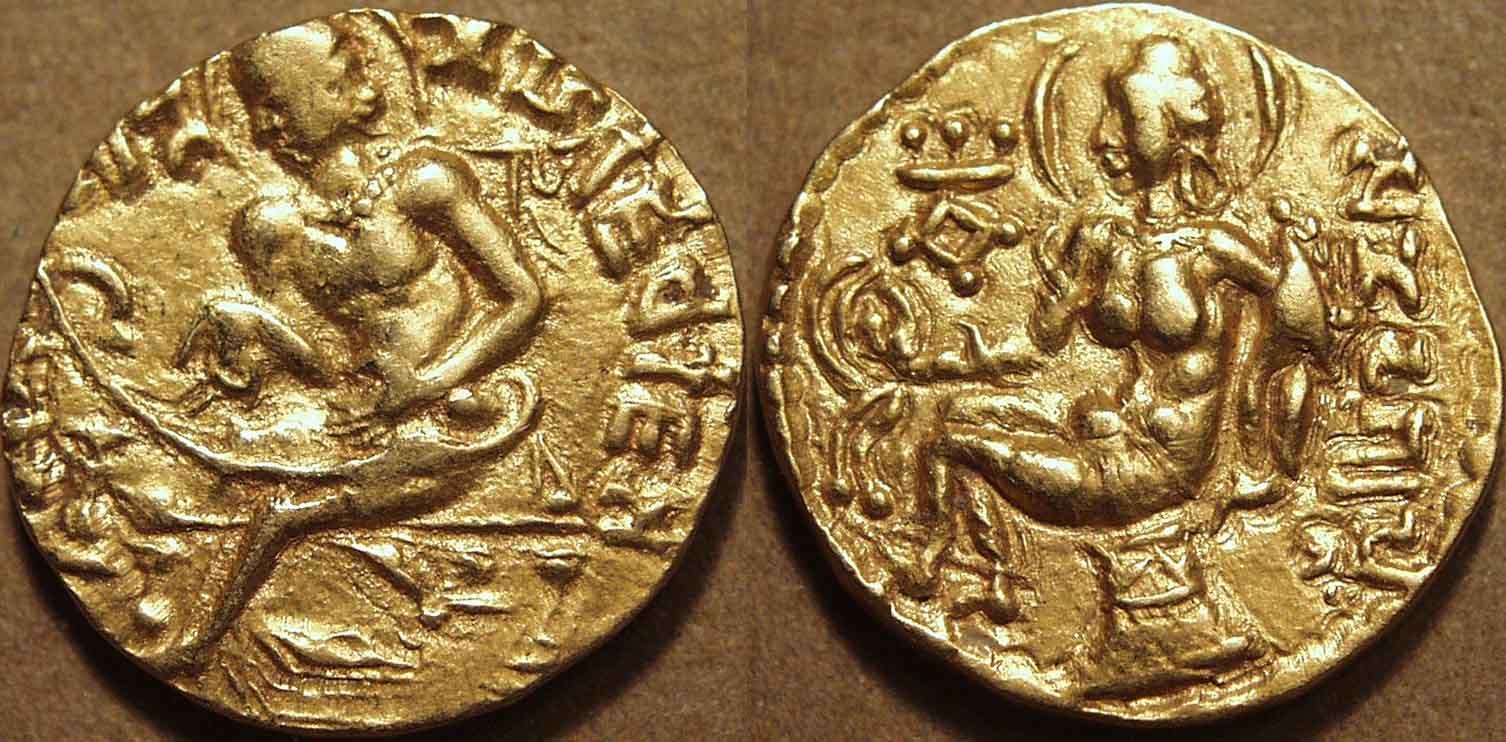In the famous story of Soṇa, the former musician, we hear the Buddha giving a simile based on the tuning of an instrument. The story appears in AN 6.55 and its various parallels: Pi Tv Kd 5, SA 254, EA 23.3, Zh Mi Kd 6, Zh Dg Kd 5, MA 123, and in various Sanskrit fragments, and probably other Vinaya passages.
The instrument is the vīṇā, which is usually translated as “lute”, but in fact it was more likely to be something in the arched harp family. They’re an instrument that remains quite close to the bow.
Arched harps are visible in several coins of Samudragupta, about 700 years after the Buddha.
As you can see, it has a resonator on one end, and a curved bow-like neck on which the stings are strung. This similar to the Saung, a very ancient instrument still used in Burma.
Thanks to the wonders of the internet, now you can actually see these being tuned. Here’s a nice clip of a modern vina being tuned. While this doesn’t resemble the ancient instrument very closely, it gives a good sense of the delicacy of the process: Indian tuning is far more fussy than Western.
Here is a clip of tuning a saung:
Here is another little clip showing just how difficult this is:
There’s no keys or even a defined notch for the strings, just a string tightened around the neck. Tuning like this is a highly skilled task.
Famously, Soṇa is asked about whether the vina sounds right when it is tuned too tight or to loose. To understand this simile it helps to know a little about traditional Indian music.
There would have been no notion of absolute pitch as we have today. Each instrument, and each singer, would have been tuned to its own natural resonance. This is called the ṭhāna.
In acoustic theory, each space or thing has a more-or-less well defined resonant frequency. This is a where the length of the sound waves matches, or divides into, the size of the thing. If you play around with a voice or instrument and you hit a resonant frequency, it’s as if the whole thing “takes off”. Suddenly the sound is not just “in” the thing, it becomes the thing. You can easily find the resonant frequency of the room you’re in, as long as it is bare enough:
There’s little wonder that the ancients believed such relationships revealed a secret harmony to the universe. Of course, its “just” physics and numbers, but, well, maybe that’s the same thing.
In European music, such frequencies are avoided. This is because the harmonic system is based on an artificial division of the octave into twelve (acoustically inaccurate) semitones, and the whole set is pitched at an absolute level, irrespective of place or player. Middle C is the same everywhere. The advantage of this is that it allows for more flexibility in harmonies, and especially the transposition between keys that is fundamental to large-scale musical construction.
This innovation, attributed to Bach, can be understood philosophically as an expression of the European tendency to detach from nature, bending nature to its will by imposing its own artificial structures upon it. In such a system pitch is egalitarian: every note has the same meaning in the absolute sense, and is only given meaning by the particular context. If you hit a resonant note, it sings out and announces itself as special.
(Incidentally, this artificiality is the secret of the blues. The famous “blues third” is a tone between the minor third and major third. It approximates the true acoustic third, which was presumably used in the traditional music of Africa. But when it’s forced into a rigid western tone-grid, it sounds like a plea to escape, like you’re reaching for your true home.)
Indian music never went down this road. It has always been based on the idea of a fundament, the ṭhāna, a basic reality that underlies all else. You can hear this is the drone of a sitar. Sitars can’t change keys. Everything else, all melody, harmony, form, and rhythm, are merely temporary variations that emerge from this and return to it.
Obviously this has strong connections with Indian philosophy. But in music at least, the philosophy is really just a theoretical explanation of the normal acoustic state of affairs. A single string, on a bow for example, resonates with its own pitch, and comes back to that.
The pitches of Indian ragas don’t force an artificial equality on intervals as does the western system. Each of them corresponds to an exact harmony of the underlying ṭhāna. Each comes from the fundamental resonance, and in turn reinforces it.
The particular ṭhāna of an instrument would be sensitively worked out by the player as they gradually learn to adjust it to the ideal pitch. It’s not just a simple matter of making it line up with a pre-determined pitch. This is what the Sona Sutta means when it refer to the vina as saravatī, literally “possessing sound”.
Obviously this would cause problems when instruments played together, and this would have to be worked out by the musicians beforehand.
So when an instrument was out of tune, it didn’t just mean that the strings clashed with each other, it meant the whole instrument was not sitting right. It just wouldn’t sing, or more technically, “resonate”. It was not saravatī.
This is very different to our more robust and industrial modern instruments. We can tune a guitar “tight” if we like and, within limits, the tone is still pretty much the same. But Soṇa’s out of tune harp would have sounded off, ill-fitting, just not right.
And just like when your meditation hits that sweet spot, you know when the energy resonates: it sings.





